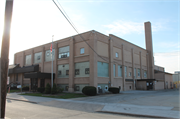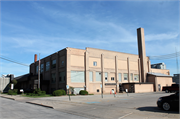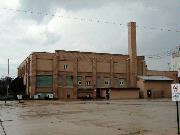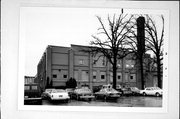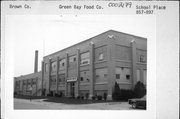| Additional Information: | RECTANGULAR BLDG W/ WINDOWS SEPARATED BY PILASTERS W/ TRIANGULAR TOPS WINDOWS ALTERED ONE-STORY SECTION AT SIDE IN SAME STYLE LARGEST PICKLE PLANT IN THE WORLD IN 1934. In photo and/or map codes, (F) stands for Fox River Valley Survey. Negatives filed with survey project.
Building has pilastered exterior wall terminating in gablets just short of the cornice. Most windows filled with glass block at a later date.
List of Historic Names includes: Green Bay Food Co.
Numerous later industrial buildings not surveyed.
HAER INVENTORY (06/1979):
That part of the Green Bay Food Co. plany inventories here is a combination one and two story structure with brick exterior, pilastered walls, flat roof, a rectangular floor plan and at least partial reinforced concrete skeleton construction. The two-story part of the facility measures approximately 100' x 100', while the one story part measures approximately 100'x 175' and is obscurred partially by new construction. The two-story part of the facility initially housed, in part, a bottling room on the first floor and office and storage on the second; while the one story part housed peeling, salting and processing rooms. The second facility also contained an onion cellar.
The Alart & McGuire Co. was organized in 182 (typo, 1892?-LP) and was said to have built the first pickle tank in the U.S. The firm constructed the one and two story structure in 1917, eight years before the company was sold to the Arnold Brothers Pickle and Preserve Co. The Arnold company, in turn, was sold to the newly-organized Green Bay Food Co. in 1929. As of 1934, the plant was called the largest pickle plant in the world, employing 300 persons year-round, shipping to 36 states, with a bottling capacity of 3,600 cases per day and a canning capacity of 2,500 cases per day. Salt tanks at the plant site had a capacity of 250,000 bushels and were said to be the largest single group of pickle tanks in the U.S. Until 1935, the Green Bay Food facility manufactured and sold only pickles and sauerkraut. In 1935, a vinegar manufacturing plant was installed. As of 1948, the Green Bay plant was processing and manufacturing pickles, vinegar, mustard, sauerkraut and salad dressing. In 1951, the facility was "completely modernized." As of 1979, pickles from the Green Bay plant were sold under the "Peter Piper," "Heifetz" and "Pesta" brands, while salad dressings were sold under the name "Hoffman House" and cranberries under "Indian Trail"- in addition to private labels.
Another name for the property was Dean Pickle & Specialty Products.
Green Bay Intensive Survey Phases 2, 3 & 4 |
|---|
| Bibliographic References: | (A) Abrahams, Paul P. Industrial Survey of Brown County, Industrial Sites, Historical Industrial Survey. Unpublished manuscript on file, Historic Preservation Division, State Historical Society of Wisconsin.
(B) Sanborn-Perris Map Co., Inc. Fire Insurance Map of Green Bay, Wisconsin. New York, 1907, 1957.
(C.) Stare, Fred A., THE STORY OF WISCONSIN'S GREAT CANNING INDUSTRY, The Canning Trade, Baltimore, Maryland, Nov., 1949, p. 4289-29.
(D.) "Pickle Plant Here Largest in World," Green Bay Press-Gazette, July 18, 1934, Wisconsin Tercentennial Edition, p. 8, Food Section, col. 3. |
|---|

